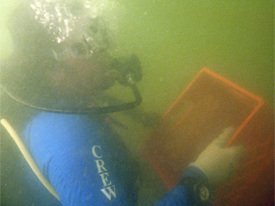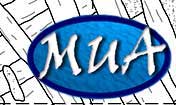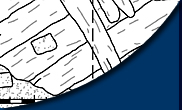The week started on Sunday, when some of the team members took a trip to the Ft. Pickens jetty area, where they were able to again experience the fun of scuba diving for relaxation and recreation. The following day, at the start of the work week, the crew returned to the EPII and B-Street sites, armed with a confidence borne of experience, knowledge, and weeks of learning how to investigate our maritime past.

Andrew Marr notes the offset timber found near the stern of EPII on Tuesday.
They arrived and continued work on the amidships unit and the new southern unit, which was recently opened to further explore the stern. A curious item was found during the morning excavations in the aforementioned south unit. Teams 5 and 6 had been excavating just outside of the hull, in hopes of acquiring a better understanding of the ship structure and wrecking event, when they encountered a timber that paralleled the portside outer hull planking. Excited that they were embarking into new territory, the teams prepared to begin their second set of dives to follow up on these new clues.
Unfortunately Mother Nature had other plans. Thunder and lightening forced the crew to pack up and return to shore. There, the team analyzed the dredge spoil from the day and found very small bone fragments, resin used to seal the inside of olive jars, cockroach wings as well as sherds of olive jar and El Morro.
On Tuesday, the crew again split up, with three students heading to the B-Street site and the rest returning to EPII. For the team at B-Street, this was the first experience with the wreck and they were astounded at the conditions that they encountered. The very nature of the site was different from the Emanuel Point ships in the shape and size of the ship, texture of the sediment, and the different techniques used for excavation in sand as opposed to silt. The crew continued to work on the first unit that was opened, moving deeper into the hull structure. While attempting to work through the shifting sand, the students encountered a wooden plank that seemed to stand out from the rest of the ship. Speculation was held off until more units could be opened and a better idea of the ship and her cargo could be ascertained.
Despite the somewhat cloudy weather, four dives were planned for EPII and these dives were conducted with no interruptions from the weather. The team had a very successful day, recovering some large ceramic sherds from the amidships unit and continuing the investigation of the strange timber outside the hull in the stern unit. One theory that was offered, suggested that this timber was part of the hull that fell outside of the existing structure during the wrecking event. Before leaving, dredge spoil was sorted on the barge. Nut shells, grape seeds, obsidian flakes, and lead sheathing were identified, along with the usual ceramic sherds and bone fragments.

Wes Perrine and Jake Shidner show off the cannonball right after its recovery, Wednesday.
Wednesday turned out some beautiful weather for the crew to get some experience with survey equipment. Their task was to use a magnetometer to conduct survey in Bayou Texar, near Pensacola Bay. This device was used to pick up the magnetic signature of iron objects on, or buried close to, the bayou floor. The magnetometer is one of the more important tools in an underwater archaeologist’s arsenal. The use of the magnetometer helped locate EPII and may help locate future sites for archaeological investigation.
Back on EPII, the rest of the crew continued operations, carefully digging deeper into the amidships and stern units. In the stern, teams continued excavations around the mysterious timber and took sediment samples from both inside and outside of the hull structure. In the amidships unit, students continued the grueling task of ballast removal and graduate student Wes Perrine recovered the third cannonball of the season!

Wes Perrine hauls ballast stones from the amidships unit to the ballast pile on Thursday.
On Thursday, a small team of students returned to the B-Street site and the rest of the crew returned to EPII. While at the B-Street site, students expanded the test trench by opening up another, one meter by one meter, unit towards the center of the hull. Much to their surprise another plank was found that seemed to match the one found on Tuesday. Further excavation only heightened curiosity and made archaeologists wonder what kind of story this vessel will tell.
Back on EPII, it was a short day. Dredging operations continued, with ballast stone removal from the amidships unit and some careful mapping of the stern. After only a few dives, the team packed up and headed back to MSC to give our equipment a good, thorough cleaning and prepare for guest lecturers that were to visit the site.
Friday began with a preparation for visitors to our site from the US Minerals Management Services and Tesla Offshore LLC, a marine geophysical and marine construction survey service company. They were given a guided tour of the wreck site and helped excavate before the weather turned bad again. As usual in Florida, the storms rolled in very quickly and the day was ended early. After returning to shore the team made their way to the UWF campus to hear an informative and enjoyable lecture from the Tesla Offshore representatives about remote survey techniques and the research they are currently conducting on prehistoric, submerged sites off of the coast of Louisiana.
Please feel free to contact us if you have any questions or concerns at: mua@keimaps.com.
Return to Project Journal home page.



